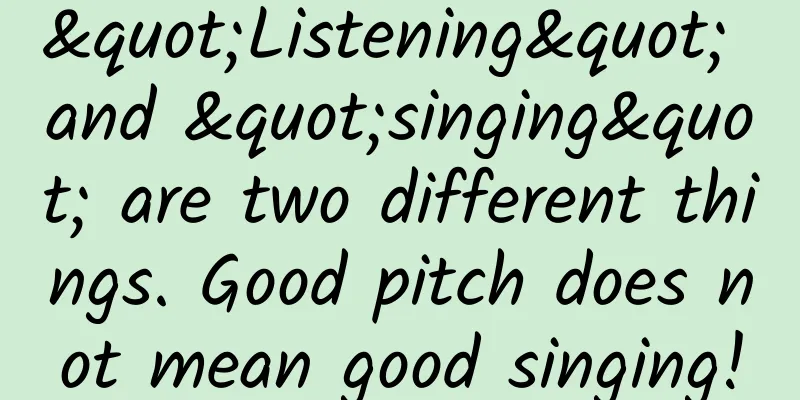"Listening" and "singing" are two different things. Good pitch does not mean good singing!

|
Singing is one of the main ways for modern people to relieve stress, relax and enhance emotions, but some people often face the KTV dilemma of "feeling good about themselves, but receiving very bad feedback from the public", and they can't help but ask themselves: Why is my pitch so bad? When it comes to pitch, we usually hear discussions about it in two scenarios: one is whether the music played by an instrument is in tune. This is something that beginners living next door should be deeply touched by, especially for instruments like violin and erhu that are difficult to master in a short period of time. For a long time, you may hear a maddening "sawing" sound, which makes us complain, "This sound is too inaccurate!" The "intonation" mentioned here is actually a description of pitch. The pitch in music must follow certain rules, and the most basic rule requires the accuracy of the pitch, that is, intonation. This intonation has a precise physical meaning, because sound is produced by the vibration of an object, so the frequency of each musical sound vibration is its physical property. The sounds used in music are not randomly generated, but are selected by people in the long-term practice process. They are generally in the range of 27.5Hz-4185.6Hz, corresponding to the 88 sounds used in the piano (A-c5). The sounds in this range are also within the human hearing range (16Hz-20000Hz). The most expressive range of vibration frequency is 65.4 Hz-1046.4 Hz, which is the area of c-c3 on the piano keyboard. In this sense, the physical property of each sound is its pitch standard. For example, the vibration frequency of the musical note e1 is 326.25Hz. If it deviates from this frequency, the sound is considered "inaccurate". In another situation, we often hear people say, "I am not good at pitch and can't tell what the sound is." Strictly speaking, the pitch here should be called "pitch sense," which is a person's hearing response to pitch. When people listen to music, they first listen with their ears instead of measuring with instruments, and how to judge depends on people's "pitch sense." The sense of pitch is divided into absolute sense of pitch and relative sense of pitch. Absolute pitch refers to the ability to accurately judge the pitch of a sound without any auxiliary reference[1]. The most intuitive manifestation is the ability to accurately judge which key on the piano the sound corresponds to. For example, people with absolute pitch will often accurately tell the pitch of a bird chirping outside the window or the sound of floor friction inside the house as a conditioned reflex. Relative pitch sense, on the other hand, is not an independent judgment of a single musical note, but is based on the relationship between sounds. The pitch it reflects cannot reflect the absolute value in the mathematical sense. People with relative pitch sense can quickly hum the corresponding score of a song after hearing it, but it is difficult for them to judge which key on the piano each note in the melody corresponds to. Many people believe that those who have absolute pitch are born that way, blessed with talent, and that acquired efforts seem to be in vain. We have to admit that the acquisition of absolute pitch does rely more on the innate auditory quality conditions, but it is not impossible to acquire this ability through acquired training. This has been confirmed by students in many music schools. After long-term music training, they can freely switch between the first key and the fixed key. Moreover, learning a musical instrument at an early stage in a child's life is very helpful for the development of absolute pitch, because this kind of pitch hearing is associated with fixed solfeggios (that is, what we usually sing, do re mi fa sol la si), and learning a musical instrument can continuously strengthen the judgment and recognition of pitch. Research data statistics show that absolute pitch is extremely rare in the United States and Europe, accounting for only one in ten thousand of the total population. Moreover, the proportion of people with absolute pitch varies among different populations. A research team from the University of California, San Diego, conducted a survey of music students in the United States and Beijing and found that the proportion of Asian students with absolute pitch was significantly higher. This difference is not only due to genetic differences, but also due to the tonal or non-tonal languages used by different populations. [2] Pitch has always been a very important threshold for learning music. Absolute pitch ability is more like a superpower in the field of music. Everyone yearns for it, but many people with absolute pitch ability still have the problem of singing out of tune. This seems puzzling at first glance. How could someone who can hear every note perfectly sing out of tune? In fact, this question is easy to understand, because "listening" and "singing" are two completely different actions. Listening is to identify with the ears, while singing is to rely on the coordination of the vocal cords and various muscles. Even if the ears are particularly sensitive and can hear accurately, it does not mean that you can control the mouth muscles well. In addition, whether or not one can sing well and accurately is also related to the singer's rhythm perception, emotion recognition and vocal range. For example, those with a narrow vocal range, even if they can hear the pitch and know which note to sing, can only hope to catch up due to their own limited conditions. Of course, people with absolute pitch do have an advantage when singing, because they can accurately judge whether they are singing accurately, quickly find where they are off-tune, and correct it as quickly as possible. Pitch training is one of the important tasks in music training, and the positive significance of music training for human development has long been confirmed in many studies. For example, the Mozart effect was proposed by French scholar Alfred Tomatis in 1991, which holds that listening to Mozart's music can temporarily improve "spatial intelligence"[3]. Later, American scholar Don Campbell promoted this concept and found that exposing newborns to certain works of Mozart is beneficial to their psychological development and has a positive effect on improving other psychological and physiological parameters such as children's creativity and attention levels[4]. The impact of music training on brain structure and function has also been verified through scientific and technological means. Through FMRI technology (functional magnetic resonance imaging), people found that the temporal lobe plane of the auditory cortex of people who have undergone music training has a larger area in the left brain, indicating that music training has an impact on the formation of brain physiological structure. [5] There are also a large number of studies showing that long-term music training can promote the growth of dendrites, axons and projections between brain regions, improve the ability to distinguish different subtle sounds and the left brain's understanding of time and space [6], which indicates that music training also has an impact on the response of activating the auditory cortex brain area. In 2011, Dartmouth College used event-related potentials to conduct a comprehensive summary of the brain resource mobilization and response sensitivity of people who had undergone music training in response to auditory stimulation. They found that music training can improve sensitivity to sound stimuli and can mobilize fewer brain resources when responding to external sound stimuli[7]. Music is an important spiritual and cultural treasure of the human world. The tremendous energy and profound beauty it contains cannot be simply quantified and evaluated with numbers. The so-called music training is to help us better understand and appreciate music. However, if we blindly follow the standard template to train our own music literacy and forget the original intention of music, it will go against the purpose. References: [1]Deutsch D. The Psychology of Music[J]. San Diego: Academic Press Inc, 1998, 265-298. [2] Ren Yue. Study on the event-related potential characteristics of auditory response of people with absolute pitch[D]. Tianjin University, 2013. [3] Rauscher FH, Shaw GL, Ky K N. Music and spatial task performance[J]. Nature, 1993,365(6447): 611. [4] Jenkins J S. The Mozart effect[J]. JRSM, 2001, 94(4): 170-172. [5] Schlaug G, Jancke L, Huang Y, etal. In vivo evidence of structural brain asymmetry in musicians[J]. Science, 1995, 267(5198): 699-701. [6] Song Bei, Hou Jiancheng. The influence of music training on brain plasticity[J]. Journal of Wuhan Conservatory of Music, 2013(001): 170-175. [7] Ellyse MG, Coch D. Music training and working memory_an ERP study[J].Neuropsychologia. 2011, 49(5): 1083-1094. |
<<: This plant mentioned in "The Legend of Zhen Huan" is gradually dying out
Recommend
New bond training video tutorial
New bond training video tutorial A complete set o...
QQ space marketing promotion, what products can be promoted by QQ space advertising?
QQ Space has 568 million active accounts, and mor...
How to measure the age of a star? It may not be as young as you think
Produced by: Science Popularization China Author:...
Tik Tok funny video editing tutorial, easily edit popular videos in two hours a day
Tik Tok funny video editing tutorial, easily edit...
This small hole on the ear is not a symbol of "wealth"! It may be a dangerous hole...
This article was reviewed by: Xiaobo Zhou, Doctor...
How to develop cross-platform mobile applications on Linux?
【51CTO translation】The past few years have witnes...
Ten things you must know about the Windows 10 conference
Microsoft launched the consumer preview of Window...
Geely started buying again, investing over 3 billion yuan to buy three automotive project companies in one go
On July 18, Zhejiang Jirun, a subsidiary of Geely...
iOS Alipay payment development (new version)
1. Introduction This article is a summary of prev...
Collection | 7 secrets to using "Toutiao" to attract traffic. It will be too late if you don't do it now!
There are many self-media platforms today, and al...
5 Ways to Use KOL Marketing
Now if you ask yourself what a KOL is, can you an...
Neuroscience tells you: How to cultivate user habits?
As Internet business matures, it has become a con...
How to build a GuangDianTong information flow account?
Guangdiantong is an advertising platform based on...
Liu Kunkun's 2021 Zero-Based Commercial Illustration Course, Phase 3 [HD]
Liu Kunkun's 2021 Zero-Based Commercial Illus...
How to effectively reduce user churn?
Like running a marriage. We gradually get used to...







![[Operation Case] In-depth interpretation of community operation, this is my ten thousand word summary after experiencing four communities](/upload/images/67cc1b445db20.webp)

